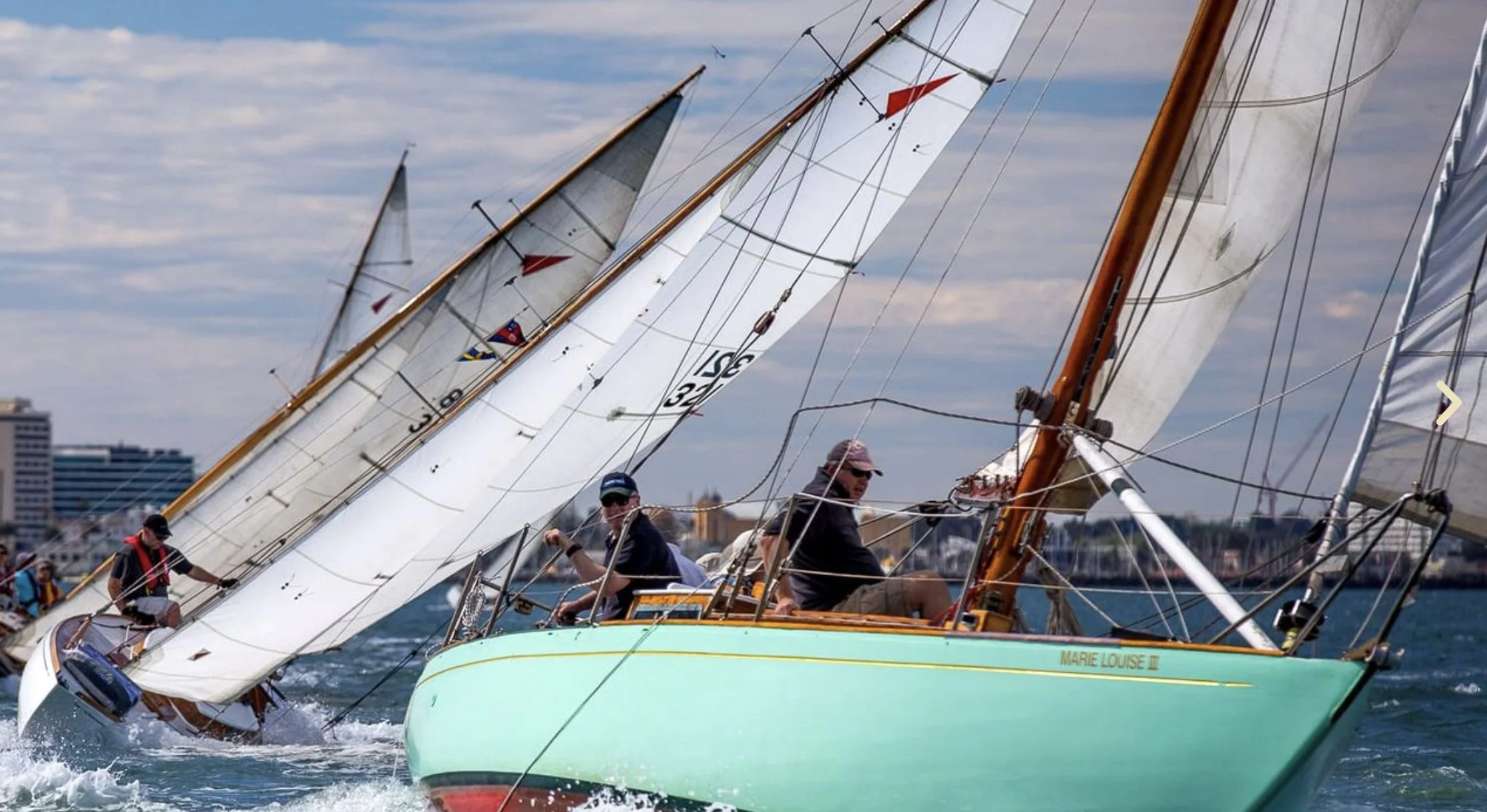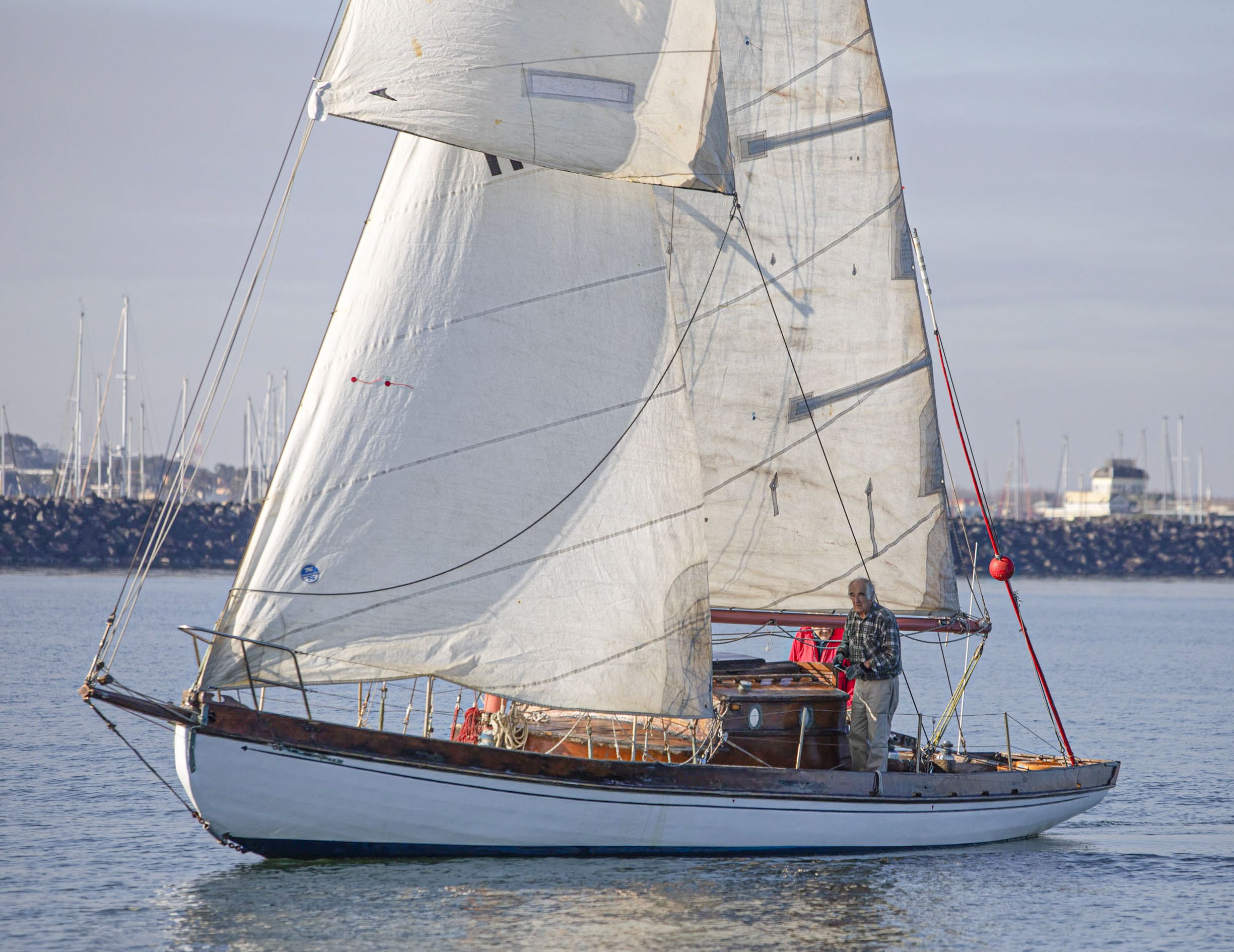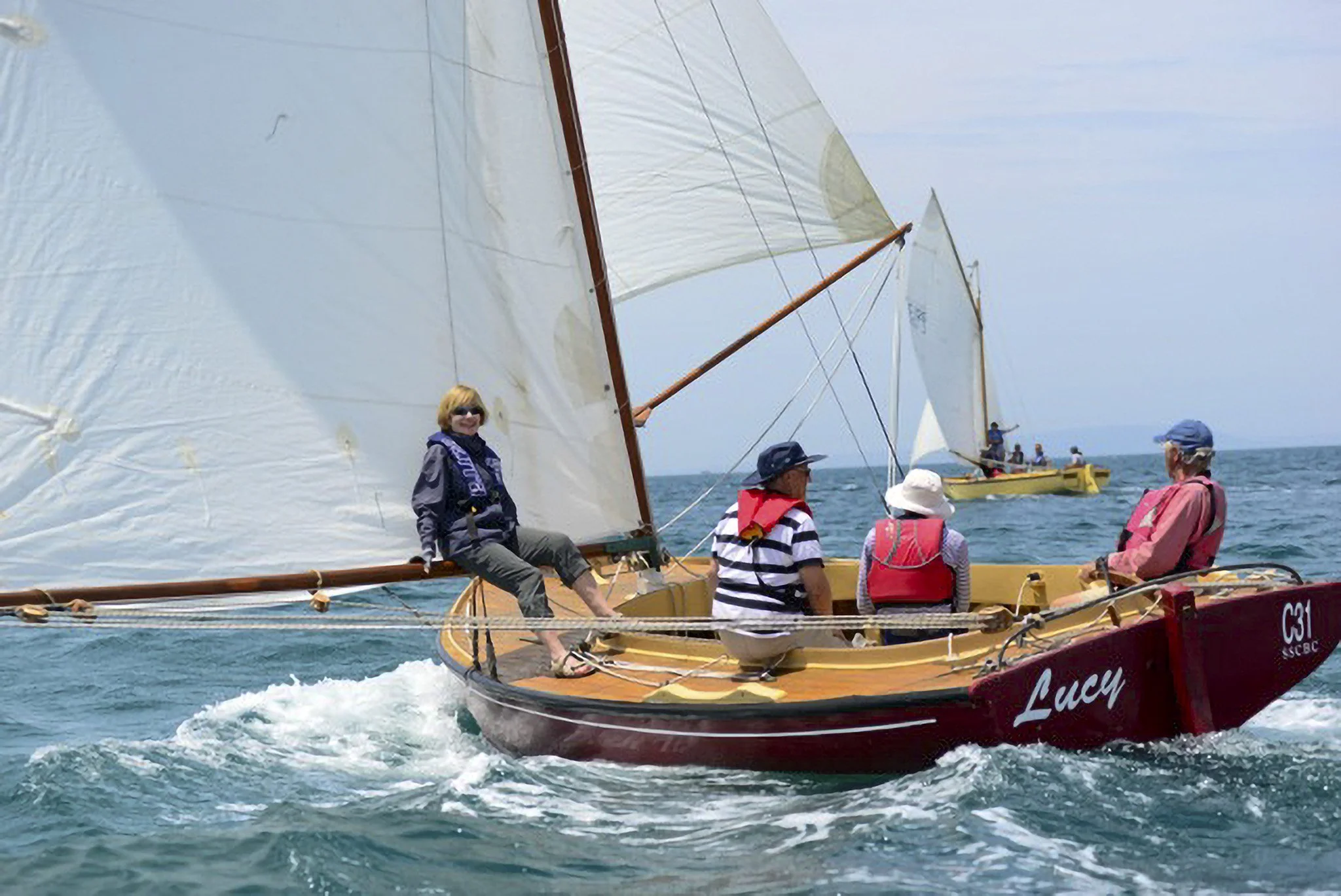Cup Regatta-The First Score
(The word SCORE meaning 20, comes from the practice, in regards to sheep or large herds of cattle, of counting orally from 1 to 20, and making a score or notch on a stick, before proceeding to count the next 20." The first citation for that use of the word score in the Oxford English Dictionary is in the year 1100.)
MARIE LOUISE III closely followed by three Tums… All signed up for the 2023 event,
With the Cup Regatta kicking off six weeks today, we have 21 racing entries confirmed and another dozen in the pipeline. In addition to this we expect to have at least 10 non-racing boats attending. It’s an eclectic mix of craft, from out and out racing boats from every decade from the 1920’s to the 1970’s, to 90 year old fishing boats, to world girdling cruisers.
To give you a taste of what to expect we thought we would visit the four corners of the entry box so far…..
The oldest boat in the 2023 Cup Regatta Fleet (so far!) is Peter Costolloe’s ALWYN
ALWYN was built in 1923 by Robert Wood and James Mackey, and named after their wives Alice and Winifred. Mackey was the grandson of James Doig Mackey, a Battery Point ship builder One story associated with the yacht is that the garage had to be demolished to remove the boat from the suburban Hobart backyard in which it was built. It appears the partners may have had a falling out as the yacht changed ownership soon after it was launched.
Alfred Blore designed ALWYN and near sisters GRAYLING and ALTURA as larger, improved versions of the popular Tasmanian One Design class, which were about 10 metres long. GRAYLING was launched in 1922, followed by ALTURA and ALWYN in the next year.
Blore had prepared plans for the One Design class around 1910. The drawings were based on an American design and six were built in Tasmania and raced in Hobart. The three new boats however were Blore's own work having deeper hull sections than the One Design hull which had a flatter floor shape. The keel shape in particular suggests Blore was aware of some of the hydrodynamic suction effects caused by different keel sections.
During the early 1920s yacht racing on the Derwent was reformed into A,B,C and D divisions, and the existing One Design class was absorbed into the 'A Class', where ALWYN and its sister ships, Blore's newer, larger and faster boats, outraced them.
ALWYN is 11.37 metres long, and the hull planking, frames and deck planking are all Huon pine. It was originally gaff-rigged and with its long bow and stern overhangs presented an elegant sight on the Derwent River. ALWYN was well known in the 1920s and 1930s and widely reported in the Mercury and Illustrated Tasmanian Mail newspapers. In 1924 and 1926 it won the prestigious Lipton Trophy at the Hobart Regatta.
The yacht was owned and helmed by Norman Wizenberg for most of its Hobart 'A Class' racing career at the Royal Yacht Club of Tasmania and the Derwent Sailing Squadron. In 1938 ALWYN was converted to race in the 'A Class' cruiser division by the then owner G.K.Evans and in 1940 the yacht was modified to a yawl rig. Other modifications included bulwarks for additional freeboard and half the original low cabin was raised to be a doghouse for full head room.
In the early 1950s ALWYN was brought to Geelong, Victoria, by Dick Collins to compete in the 'A Class' racing events at the Royal Geelong Yacht Club. From this time until the 1960s ALWYN's provenance is not as well documented. It was on the Royal Yacht Club of Victoria register named CYGNET and then on the Royal Melbourne Yacht Squadron list as PANDORA when owned by Bill Elliot (son of Phar Lap's jockey in the USA, Billy Elliot). Bill Elliot owned the vessel from about 1961 to 1974, and changed the name back to ALWYN when he moved across to Hobsons Bay Yacht Club. When Bill passed away at a young age the vessel passed to his brother-in-law, the current owner.
For the last 40 years ALWYN has been on the Hobsons Bay Yacht Club's register and a notable competitor in local club racing, and Australia Day regatta racing to Geelong. In 2008 ALWYN raced with the Classic Yacht Association of Victoria on Port Phillip Bay. To show its racing pedigree after 83 years, ALWYN won the 2006 Royal Yacht Club of Victoria Lipton Cup Classic Yacht Trophy.
The original hull and deck planking is intact, but the floor timbers, deck beams and chain plates have been replaced using original dimensions, The structure still illustrates typical Tasmanian boatbuilding techniques of the period. It has a Bermudian sloop rig, which the current owner hopes to convert back to the 1920s fractional rig sail plan which Alfred Blore specified for GRAYLING and ALTURA. Sailing again in 2013, the hull has been fully splined during a three year project, with more work planned in due course.
The youngest boat (by design not launch date) in the 2023 Cup Regatta Fleet (so far!) is the newly arrived MERCEDES IV from 1974
Martin Ryan (Custodian of MERCEDES III) rights…Mercedes lV’s bloodlines are truely Classic:
Designer: Kaufman Builder: Quilkey Length: 41’11”, beam 3.88 and draft 2.30
The objective of the design and construction was the Admiral's Cup team of 1975 alongside LOVE AND WAR, and BUMBLEBEE lll. The team finished 9th in an Admiral’s Cup dominated by light winds.
She has done 15 Sydney Hobarts with a 4th overall in 1974, 6th overall in 1984, and 3rd in her division in the well-remembered 1998 race, placing 13th overall.
Mercedes lV was at RYCV in the late seventies and Doug Shields raced on her. Historical records are scant but RYCV has her documented as winning the 1979 Cock of the Bay on line honours.
For the last ten-plus years she has mainly cruised from Pittwater. She participated in the 50th Anniversary Admiral’s Cup Regatta in 2017, finishing 5th against stiff competition.
The Syndicate’s immediate plans are to participate in our Classic fleet racing including the Cup Regatta, obtain an AMS rating, and race in the 2023 Cock of the Bay, joining previous winners from the Classic fleet KINGURRA and MERCEDES III
So, watch out for the grey-hulled yacht and if the winds are favourable for a spinnaker, “Big Red” will likely make an appearance.
The longest boat in the fleet including sprits and booms etc (so far) is Col Anderson’s spectacular ACROSPIRE III at 59ft.
Acrospire III at the GWBF Image-T. Smeeton
Thanks to the ANMM Register of Historic Vessels
ACROSPIRE III is a 50 foot long gaff cutter, carvel planked in New Zealand kauri. It was designed by Charlie Peel, a Victorian born designer and builder well known for many yachts that raced in Victoria and NSW, in particular his designs for the 21 Foot Restricted Class. It was built during 1923 and early 1924 in Sydney at James Hayes and Sons yard in Careening Cove. Peel was working there at the time, and was part of the team building his design. ACROSPIRE III was built for Joe White, then Vice Commodore of the St Kilda Yacht Club and a prominent yachtsman in Victoria. It was built with the intention of being Victoria’s challenger for the Sayonara Cup, an event that had not been raced for since 1911 when it was won by NSW. White had a brewing business, and the name ACROSPIRE is taken from the term that relates to a stage in the grain used in brewing. When it has grown its first shoot it is the right time to use the grain, and that shoot is called the ‘acrospire’. His previous yacht the 7.62 m long ACROSPIRE II was built in 1911 for racing on the lake at Ballarat. ACROSPIRE (I) remains elusive, but one newspaper record shows it raced in a mixed fleet including the 7.6m long IDLER suggesting it may have been one of the early square-sterned racing yachts popular on Port Phillip in the early 1900s
ACROSPIRE III was completed in early 1924 and shipped to Melbourne aboard the SS ECHUNGA, arriving there in mid-February. It was launched, rigged and sailed on Port Phillip in the A class. Amongst the fleet was EUN-NA-MARA , which won the 1910 series for NSW under the name CULWULLA III. ACROSPIRE III was designed to rate as an 8 metre and provide an even match with the likely defender of the cup for NSW, which would also be an 8 metre class yacht. However ACROSPIRE III’s construction proved too light for the rough conditions on Port Phillip and it was strengthened, adding weight. The outcome was that the yacht sat lower in the water than intended by the designer and with a longer waterline it ended up rating nearly 9 metres.
The Sayonara Cup series was eventually organised for early 1928, and by this time White was commodore of the St Kilda Yacht Club. The cup rules required the yacht to sail from Victoria to NSW, and ACROSPIRE III left Williamstown on Boxing Day 1927, starting out in rough conditions. Light winds were encountered off the NSW coast until just after Jervis Bay when they met strong NE headwinds, and they eventually sheltered in Kiama until a southerly change had swept through. On the tail of that wind they made Sydney Heads early on the afternoon of January 2 1928.
Four NSW yachts were available as possible defenders of the Cup, RAWHITI rating 11 metres, CARINA, 9 metres and the two 8 metres NORN and BRAND V. NORN was chosen as the NSW defender, and the first race took place on 21 st January with NORN measured at 8.03 metres and ACROSPIRE III at 8.83 metres, giving NORN a substantial handicap advantage. The race was sailed in a north east breeze, and ACROSPIRE III gradually took the lead on the windward beat to be nearly 3 minutes ahead at the windward mark, increasing this to almost four minutes at the finish. This was not enough to win on handicap, and NORN’s rating advantage gave it a win by 3 and ½ minutes. The second race was sailed in light conditions, and NORN took the lead on when the southerly turned toward the east and then north east during the second leg and it was better placed to pick up the new breeze. ACROSPIRE III made up some ground on the final leg as the breeze freshened, but NORN ended up winning by a huge margin of just over 23 minutes. The cup was therefore retained by NSW, and ACROSPIRE III returned to Victoria.
Joe White then commissioned a new design from Peel for the Sayonara Cup and this became the 9 metre ACROSPIRE IV which was launched in 1929.
ACROSPIRE III remained in Victoria racing in the A class during the 1930s. The sail number changed from S1 to S17 when ACROSPIRE IV was launched. ACROSPIRE III was changed to a Bermudan rig in the early thirties and sold to Hobart owners around 1938 where sailed under the new name ACUSHLA. It raced in A division until after 1948 when it sailed to Sydney with a new owner RA and JAS Dickson and was renamed WAREE. in the 1949/50 season it won the RSYS Norn Cup.
An anonymous correspondant wrote about WAREE in Seacraft Magazine early in the 1950s:
" At the time of writing, WAREE is sitting forlornly on the RSYS slip awaiting a new owner.....WAREE was being raced hard and consistently. She's an old-timer, but a real whizzer, with an underbody that bears a striking resemblance to some of the really modern designs....
Boats like WARREE were built as day sailers 40 to 50 years ago, so it didn't matter if they were wet, and they certainly were just that; they had less freeboard than some of the modern counterparts like the Bluebirds, which have onnly half the length of WAREE's ilk. On the other hand, of course, driving WAREE hard in a breeze with her stern wave roaring astern gives such a thrill as could never be had from a Bluebird, no matter how hard you drove her".
A subsequent owner was well known ocean racing skipper Bill Psaltis. He raced it for a few years before selling it to an owner who left it on a mooring off Scotland Island in Pittwater and rarely used it. The yacht was later was purchased in poor condition by Sandra and Michael Paul who had a property on the island and enjoyed having the graceful yacht to look at from their window. Unfortunately it was not used and kept afloat at times by regular pumping out from local marine tradesman Ian "Bomber" Treharne. It is even understood that it sank on at least one occasion. He eventually suggested they donate the yacht to the current owner who had experience with other yacht restorations including WAITANGI and SAYONARA
In 1996/97 ACROSPIRE III was returned to Melbourne and completely restored by the current owner to its original gaff cutter configuration. In 2012 it races with the Classic Yacht Association of Australia in events on Port Phillip.
The shortest boat in the fleet (so far) is the Couta Boat LUCY at 22 ft. 4 in.
LUCY was built by Ken Lacco in Rosebud, Victoria in 1931. Ken was the son of Mitch Lacco, the well-known boatbuilder who conducted his business in Queenscliff at the entrance to Port Phillip. When the Lacco family moved to Rosebud in the late 1920s, Ken took over the responsibility of the family business. Lucy was one of the first of the Couta Boats to be built by young Ken. She was named after Ken’s sister who worked as a sailmaker in the Lacco business.
She has a long and well documented list of custodians on the wonderful Register of Couta Boats on the Couta Boat Association Website.
Today’s custodians are syndicate and since they purchased, LUCY she has been moored near The Baths at Sorrento and sailed regularly in the Division 2 fleet at the SSCBC. She has won significant titles, including: Champion Aggregate, the Couta Boat Association National Titles, State Titles and the Portsea Cup.
In addition to the regular SSCBC sailing, LUCY has competed in regattas conducted out of both Sandringham and St Kilda in Melbourne. She has also sailed to and from Geelong to compete in the 2014, 2016, 2018 and 2020 Biennial Yanmar Wooden Boat Shop Wooden Boat Festival. In November 2019, Lucy was an entrant in the Classic Yacht Association Australia at Williamstown, Victoria.
The journey to and from such regattas constantly tests the crew’s capabilities, but the experience of sailing a boat with a history of 90 years always brings immeasurable pleasure.





